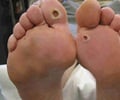
"We wanted to mimic the function of health beta-cells, which produce insulin and control its release in a healthy body," Dr. Zhen Gu, lead author of the paper describing the work and an assistant professor in the joint biomedical engineering program at North Carolina State University and the University of North Carolina at Chapel Hill, said.
"But what we've found also holds promise for smart drug delivery targeting cancer or other diseases," the researcher said.
The researchers created a spherical, sponge-like matrix out of chitosan, a material found in shrimp and crab shells.
Scattered throughout this matrix are smaller nanocapsules made of a porous polymer that contain glucose oxidase or catalase enzymes.
The sponge-like matrix surrounds a reservoir that contains insulin.
Advertisement
When a diabetic patient's blood sugar rises, the glucose triggers a reaction that causes the nanocapsules' enzymes to release hydrogen ions.
Advertisement
The positively charged chitosan strands then push away from each other, creating larger gaps in the sponge's pores that allow into the bloodstream.
As the insulin is released, the body's glucose levels begin to drop. This causes the chitosan to lose its positive charge, and the strands begin to come back together.
This shrinks the size of the pores in the sponge, trapping the remaining insulin.
The study is published online in ACS Nano.
Source-ANI













